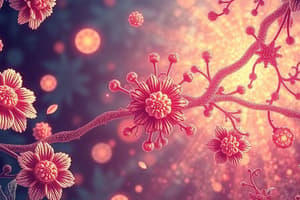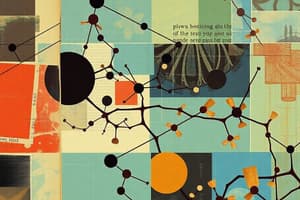Podcast
Questions and Answers
What is the primary focus of pharmacodynamics?
What is the primary focus of pharmacodynamics?
- The study of drug interactions with food
- The study of how drugs are absorbed in the body
- The study of drug manufacturing processes
- The study of how drugs produce their pharmacologic effects (correct)
What term describes substances that activate receptors to produce a biological response?
What term describes substances that activate receptors to produce a biological response?
- Agonists (correct)
- Antagonists
- Inhibitors
- Enzymes
Which of the following is NOT a type of drug receptor mentioned?
Which of the following is NOT a type of drug receptor mentioned?
- Microorganisms (correct)
- Membrane transport molecules
- Enzymes
- Hormones
How do drugs primarily achieve their therapeutic effects?
How do drugs primarily achieve their therapeutic effects?
What is the relationship between pharmacokinetics and pharmacodynamics?
What is the relationship between pharmacokinetics and pharmacodynamics?
What is a common analogy used to explain drug-receptor interaction?
What is a common analogy used to explain drug-receptor interaction?
What is one mechanism other than drug-receptor interaction through which drugs can act?
What is one mechanism other than drug-receptor interaction through which drugs can act?
What defines antagonists in pharmacological terms?
What defines antagonists in pharmacological terms?
What is the primary purpose of the signal transduction pathway initiated by drug binding?
What is the primary purpose of the signal transduction pathway initiated by drug binding?
Which type of receptor interacts specifically with neurotransmitters?
Which type of receptor interacts specifically with neurotransmitters?
What is meant by 'affinity' in relation to drug-receptor interactions?
What is meant by 'affinity' in relation to drug-receptor interactions?
How do agonists differ from antagonists?
How do agonists differ from antagonists?
What occurs when a drug leads to reduced receptor sensitivity?
What occurs when a drug leads to reduced receptor sensitivity?
Which of the following accurately describes neurotransmitter transporters?
Which of the following accurately describes neurotransmitter transporters?
What role do secondary messenger molecules play in signal transduction?
What role do secondary messenger molecules play in signal transduction?
What characterizes a strong bond formed between a drug and its receptor?
What characterizes a strong bond formed between a drug and its receptor?
Which physiological processes can hormones affect?
Which physiological processes can hormones affect?
What primarily determines the potency of a drug?
What primarily determines the potency of a drug?
Flashcards
Pharmacodynamics
Pharmacodynamics
The study of how drugs interact with the body to produce their effects, focusing on the mechanisms of action.
Drug receptors
Drug receptors
Specific protein molecules within the cell or on the cell membrane that receive and interact with specific hormones or neurotransmitters.
Agonists
Agonists
Substances that bind to and activate receptors, triggering a biological response.
Antagonists
Antagonists
Signup and view all the flashcards
Homeostasis
Homeostasis
Signup and view all the flashcards
Pharmacokinetics
Pharmacokinetics
Signup and view all the flashcards
Steady state
Steady state
Signup and view all the flashcards
Drugs
Drugs
Signup and view all the flashcards
Signal Transduction Pathway
Signal Transduction Pathway
Signup and view all the flashcards
Ligand
Ligand
Signup and view all the flashcards
Receptor Classification
Receptor Classification
Signup and view all the flashcards
Membrane transport molecule
Membrane transport molecule
Signup and view all the flashcards
Affinity
Affinity
Signup and view all the flashcards
Efficacy
Efficacy
Signup and view all the flashcards
Potency
Potency
Signup and view all the flashcards
Drug tolerance
Drug tolerance
Signup and view all the flashcards
Study Notes
Pharmacodynamics Overview
- Pharmacodynamics is the study of how a drug affects the body
- It focuses on the mechanisms of action of drugs and the effects they produce.
- It essentially answers the question, "What does the drug do to the body?"
Learning Outcomes
- Define pharmacodynamics
- Explain types of drug receptors, including:
- Receptors for hormones and neurotransmitters
- Enzymes
- Membrane transport molecules
- Other macromolecules
- Explain drug-receptor interactions
- Define terms related to drug-receptor interactions such as:
- Agonists
- Antagonists
Pharmacodynamics vs Pharmacokinetics
- Pharmacodynamics describes what the drug does to the body
- Pharmacokinetics describes what the body does to the drug
Examples
- Drugs can have various effects on the human body
Mechanisms of Drug Action
- Drugs act through diverse chemical mechanisms
- The most common mechanism is drug-receptor interaction.
- Other mechanisms include interacting with nucleic acids, transport proteins, enzymes, and interfering with osmotic cell balance.
Drug-Receptor Interaction
- To induce therapeutic or harmful effects, drugs bind to receptors in the body. This is the pharmacodynamic phase of drug action.
- Drug-receptor interaction is often described using the "lock-and-key" analogy
Receptors (Locks)
- Tissues use receptors to differentiate between different chemical messengers (e.g., drugs, hormones, neurotransmitters)
- Receptors are protein molecules found within cells or on cell membranes (cell wall)
- Receptors are specific, binding to particular hormones or neurotransmitters
Drug Receptors
- Receptors bind to "chemical messengers" (drugs)
- Drugs' effects stem from their interaction with receptors
Drug Receptors (continued)
- Most receptors bind to one or more endogenous substances (e.g., neurotransmitters).
- The proper binding triggers a signal to the cell, resulting in a response by the cell.
Drug Receptors (continued)
- Binding to receptors or other targets can initiate a signal transduction pathway.
- This cascade of events ultimately produces a physiological effect in the cell.
- Examples include changes to a cell's function, secondary messenger molecules, structural and/or chemical alterations.
Types of Receptors
- Receptors for hormones and neurotransmitters
- Enzymes
- Membrane transport molecules
- Other macromolecules
Hormones and Neurotransmitters
- Hormones are chemical substances produced and secreted by glands, influencing various bodily processes (e.g. growth, mood)
- Neurotransmitters are chemical substances that transmit impulses between nerve cells (neurons)
Hormones and Neurotransmitters (continued)
- Neurotransmitters are released from presynaptic neurons, cross a synapse, and stimulate a postsynaptic neuron.
Receptors for Hormones and Neurotransmitters
- Ligands (drugs, hormones, neurotransmitters) bind to protein molecules within/on cell walls.
- Receptors are classified according to the ligand they bind
- The ligand-receptor binding may be weak and reversible or strong.
Receptors for Hormones and Neurotransmitters (continued)
- Ligand binding to an exterior protein protrusion can modify the receptor and signal the cell.
- The binding can create openings in the cell membrane allowing the passage of specific substances.
- Ligands can pass through cell membranes and connect to receptors within the cell.
Enzymes
- Enzymes are proteins that catalyze intra- or extracellular reactions
- Some membrane-bound enzymes act as receptors, with binding directly affecting the cell.
Membrane Transport Molecules
- Membrane transport proteins facilitate movement across cell membranes.
- Some membrane proteins (channels) allow charged particles to pass through when stimulated.
Membrane Transport Molecules (continued)
- Neurotransmitter transporters prevent neurotransmitters from leaking from the synapse and return them to the presynaptic neuron.
Other Macromolecules
- Steroid receptors move through the cell to the nucleus
- DNA can act as a receptor for substances bound directly to amino acids.
- Lipids and phospholipids, parts of cell membranes, can act as receptors for various substances.
Drug-Receptor Interactions: Binding
- Drugs initiate cellular responses by binding to receptors.
- The drug forms a weak bond with the receptor protein.
- The bond is reversible, so as the drug concentration in the tissue drops, the drug dissociates from the receptor.
Receptor Selectivity
- Receptors are specific molecules, usually proteins, that interact with specific drugs, causing regulatory function changes.
Drug & Specificity
- A drug is any substance that interacts with a molecule or protein in living systems to perform regulatory functions.
Drug-Receptor Interactions: Affinity, Efficacy, and Potency
- Affinity is a drug's ability to link to a receptor.
- Efficacy is a drug's capacity to create the intended cellular effect
- Potency is primarily determined by the drug's receptor affinity.
Drug-Receptor Interaction: Affinity
- Affinity is the tendency of a drug to bind to its receptor.
- The degree of affinity influences the needed concentration of the drug.
- Affinity is a major factor determining drug potency.
Drug-Receptor Interaction: Efficacy
- Efficacy is the ability of a drug to initiate a cellular effect.
- It is independent of affinity, differing among drugs binding to receptors.
- Drugs with both affinity and efficacy are agonists.
- Drugs with affinity but low efficacy are antagonists.
Agonist
- An agonist is a drug binding to and activating a receptor.
- Agonists exhibit both affinity and efficacy for the receptor.
- Agonists result in the binding to the receptor and a physiological response.
Drug Tolerance
- Repeated doses of the same agonist can reduce the responsiveness of receptors.
Antagonist
- An antagonist is a drug that binds to a receptor, preventing its activation.
- Antagonists only have affinity to a receptor, but not efficacy.
- Antagonists block receptor activation by agonists.
Agonists and Antagonists
- Antagonists block receptor activation by agonists
- Agonists activate receptors
- Antagonists bind to receptors, blocking activation,
Class Activity
- Research HMCAS CPGs to list agonists and antagonists
Assignment #2
- Complete an assignment related to pharmacodynamics.
Summary Overview
- Types of receptors
- Receptors for hormones and neurotransmitters
- Enzymes
- Membrane transport molecules
- Other macromolecules
- Drug-receptor interactions.
- Agonists/Antagonists
Questions?
- Ask any questions to clarify your understanding of the subject matter.
Studying That Suits You
Use AI to generate personalized quizzes and flashcards to suit your learning preferences.




